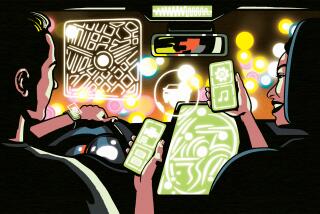Market’s Chancy for Automotive Gadgets
- Share via
Aided by motorists’ seeming insatiable appetite for electronic devices that blink, blare and warn, automotive gadgets have come a long way since the days of curb feelers and cruise control.
But the market is a turbulent one, due to changing consumer tastes and styles. Even government regulation can affect the popularity of products, which run the gamut from add-on car computers that measure everything from gas consumption and outside air temperature, to now-forgotten products such as the CB radio.
Several years ago a Palo Alto company, for instance, produced an accessory brake light called the Cyberlite that was said to be more visible because it would flash at a faster rate under hard braking. But sales were lackluster because third brake lights were banned in many parts of the United States.
Hit the Big Time
By the time the federal government began mandating the extra brake lights in 1986, Cyberlites were no longer being sold.
By contrast, the inventors at Etak Inc. of Menlo Park hit the financial big time with their electronic navigational system before the device even went into regular production.
Company officials said General Motors in 1985 paid a “substantial” amount for the exclusive rights to use the $1,400 gadget in GM cars and trucks. More recently, the technology has been licensed to Bosch Corp. and Clarion Corp. of America, according to marketing director Don Warkentin.
The self-contained computer-based device actually shows a driver where he is and where he is going by combining wheel sensors, a compass, a modest computer and electronic maps embedded in a tape cassette. The result is a relatively simple “dead reckoning” type of navigational system that doesn’t rely on any outside signals or require any programming by the driver.
Analyzing Driving Skills
Another unusual device is the so-called G-analyst made by Valentine Research Inc. of Cincinnati.
The $379 device is intended to aid motorists in improving their driving technique by measuring and digitally displaying braking, acceleration and cornering forces on a small dashboard-mounted screen.
Company President Mike Valentine takes umbrage at his product being referred to as a gadget. But he concedes that its value may be lost on many drivers. Still, Valentine expects sales of the product, which has only been on the market since January, to be strong. For car enthusiasts and race car drivers, he said, using the G-analyst “is a lot cheaper than going to (professional) driving school.”






